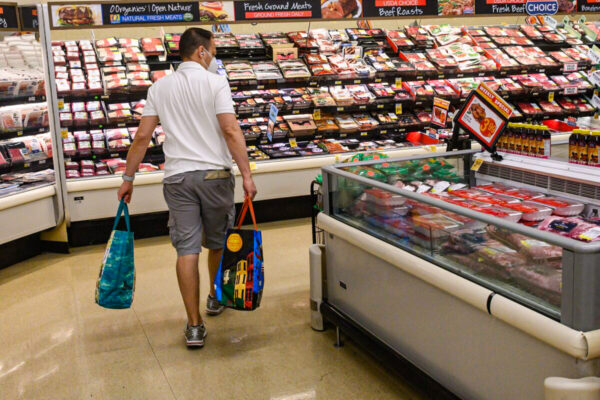US Households Struggling to Save in an Inflationary Economy
A new report revealed that U.S. households are increasingly struggling to save money as the cost of living continues to impact Americans.
According to Morning Consult‘s Household Finances & Spending survey in July, the share of adults who had money left over after paying monthly expenses declined for all income categories.
Fewer than 40 percent of households earning less than $50,000 reported having money after covering their expenses at the end of the month. This is down 6 percent compared with the same time a year ago.
Sixty percent of households making between $50,000 and $99,999 had money left over, down from nearly 70 percent in July 2021. Nearly 80 percent of Americans with annual incomes of more than $100,000 had leftover money after paying their expenses, down by 5 percent from a year ago.
In addition, there was a 2 percent net change in the number of households where monthly expenses were greater than income. There was also a 4 percent and 2 percent increase for middle- and high-income Americans, respectively.
“[N]ot only are adults below this income threshold consistently less likely to report being able to save each month, but the share who said they have money left over each month has trended lower over the past year,” the report stated. “This pattern holds especially true for middle-income earners, who had the most pronounced contraction in their ability to cover expenses—let alone save—in July.”
Although consumers have been lauded for accumulating plenty of savings during the coronavirus pandemic, a slew of data highlights that these savings are being evaporated due to the cost-of-living crisis.
Is Inflation Evaporating Savings?
Last month, New York Life’s latest Wealth Watch survey found that 36 percent reported drawing down an average of $617 from their savings in the first half of 2022. Generation Xers, a population born between 1965 and 1980, withdrew the most from their savings for everyday costs, at an average of $644.

The same survey learned that 30 percent of Americans are “uncertain” and 29 percent are “anxious” about their finances. Researchers highlighted that inflation remains consumers’ biggest concern, followed by health care costs and the national economic recovery. Eighty-nine percent are worried about a recession.
“The financial picture for many Americans has changed significantly since the start of the year, and we’re seeing the positive expectations many Americans held about their finances heading into 2022 start to fade,” said Aaron Ball, senior vice president, Head of Insurance Solutions, Service, and Marketing, New York Life, in a statement.
With the annual inflation rate standing at 8.5 percent and real wage growth at negative 3.6 percent, market experts are not surprised that the personal savings rate collapsed, to 5.1 percent in June, the lowest level since 2008, according to the Bureau of Economic Analysis (BEA).
A recent American Consumer Credit Counseling survey discovered that 40 percent of consumers could not afford to transfer money into their savings accounts. Nearly one-fifth (19 percent) said they had to cut their savings rate, and 23 percent reported having no emergency savings at all.
“The pandemic, wars overseas, and other world events have had unprecedented effects on our society when it comes to household finances,” said Allen Amadin, president and CEO of American Consumer Credit Counseling, in a statement. “Consumers have been going through many different financial phases in a very short period of time, forcing them to pivot several times according to the challenge.”
As prices for basic goods and services continue to remain elevated, more households are taking on debt.
A recent LendingTree study, for example, found that 43 percent of Americans expect to rely on debt over the next six months. This is especially pronounced among young adults and parents with young children.
In June, consumer credit increased by $40.15 billion, topping the market estimate of $25 billion. This represented the biggest monthly gain in consumer credit since March. Revolving credit, which includes credit cards, surged by $14.8 billion. Non-revolving credit, which consists of automobile and student loans, advanced by $25.36 billion.
With interest rates rising, it will become more challenging to service debts and harder to access credit. According to the Federal Reserve Bank of New York’s Survey of Consumer Expectations, 57 percent say it will be harder to obtain credit one year from now. Further, the mean probability of not being able to make minimum debt payments over the next three months remained heightened, at nearly 11 percent.
WalletHub statistics further suggest the cost of existing credit card debt rose by as much as $14.5 billion because of the Federal Reserve’s rate hikes.
“The best thing people can do to minimize the impact of Fed rate hikes is to pay down their credit card debt as quickly as possible. Credit card rates are quick to react to Fed changes, making existing debt instantly more expensive,” said Delaney Simchuk, WalletHub analyst, in the report.
Conditions might not improve as Americans’ overall satisfaction with their financial conditions clocked in at a 12-month low, J.D. Power data show. Sixty-four percent say they are financially unhealthy.
[ad_2]
Source link



